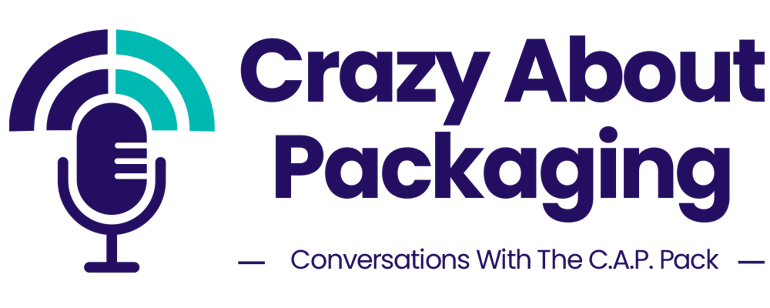
In episode 8 of the Crazy About Packaging podcast, we discussed ICPG’s latest material solution: Resource Efficient Barrier Alternative (RE-BA). RE-BA is a reimagined food packaging solution that provides efficient barrier to protect food from moisture or contamination — all without compromising food packaging sustainability.
In episode 10 of our podcast, join the C.A.P. Pack as we dive deeper into RE-BA and what it means for the food packaging industry.
Sneak Peek for Episode #10
Check out the latest podcast to hear us discuss the impact RE-BA can have on food packaging safety and sustainability. You can watch or listen on our website or subscribe on Spotify, Apple, or Google. Want a sneak peek? Read on to see a little bit of what we cover.
What is “Barrier” in Food Packaging?
Before we get into RE-BA and the ways it can transform barrier packaging, let’s address the biggest question: what is barrier?
In packaging, “barrier” is the protection between food and the outside elements, specifically those elements that are capable of permeating typical packaging materials — particularly oxygen and moisture vapor.
As Jonathan explains it, “It's basically the incorporation of materials into a structure that create a torture path for oxygen and moisture transmission so you can control the atmosphere inside that package and keep it safe and at the same time extend shelf life.”
There are plenty of examples of packaging materials and processes that provide a strong barrier between the food and the outside world. For example, food stored in metal cans have a distinct barrier that does not allow transmission of moisture. The real challenge came when the industry began searching for ways to replicate that barrier protection for new products — an ask that required new material options.
What Material Solutions are Currently Used for Barrier Applications?
Most packaging materials provide some inherent protection from the outside world. However, not all materials are suitable for every application, which often means they must be co-extruded with other materials or otherwise adapted in order to provide the required food packaging safety.
Some of the many examples of materials currently in use as barrier solutions include but are not limited to:
- Polypropylene: With its inherent moisture barrier capabilities and heat tolerance, PP is a good solution for a wide range of packaging processes, including hot fill. However, it is not an effective oxygen barrier, which means that it often requires co-extrusion with other materials.
- EVOH: EVOH can be co-extruded with other materials, providing effective moisture and oxygen barrier. It is becoming increasingly more common. However, the material is very expensive, so the structures are becoming more and more simplified.
- PET: This material has some natural barrier properties. However, in order to further shelf life of products, PET often must be laminated. This presents a problem because laminated PET can’t be recycled.
How Do Typical Solutions Compromise Food Packaging Sustainability?
So what is the problem with many of the material solutions currently available? They’re not sustainable!
When materials are laminated or co-extruded with other materials, their barrier properties do increase — but they can also become problematic for the recycler. As Natalie explains, “Certain polymers are given a resin ID code, which is used to aid in recycling. So PET is a number 1 and polypropylene is a number 5. Some combinations of materials are given a number 7. For a lot of those materials where this combination has been made, you cannot separate it for the purposes of recycling and you cannot recycle that PET with that polypropylene because it will lead to contamination in the recycling stream, which essentially renders that stream useless.”
With the exception of PP/EVOH structures, these materials, while effective at their primary goal — food safety and extended shelf life — are failing when it comes to food packaging sustainability. They can’t be recycled efficiently, leading to more waste.
A true barrier solution must offer both food safety and sustainability. That’s where RE-BA comes in.
What Does RE-BA Do Differently?
ICPG’s barrier solution, RE-BA, is a component of our XPP polypropylene structure. Instead of co-extruding, coating, or laminating materials, RE-BA creates a barrier through a tortured path when combined with XPP. The result is a monomaterial solution that can be recycled in both infrared and water displacement recycling streams. It’s a more efficient, more sustainable solution for barrier applications.
Mike explains the different approach ICPG took when creating RE-BA: “We are designing materials to be used in thermoforming applications for recyclability. It's at the front of our decision-making. We understand the complexities. Jonathan and I especially have gotten very close to the recycling systems and really have listened and learned. So we are focused on materials — in this case, polypropylene — that can meet recycling standards.”
With RE-BA, there were two goals from the start:
- Keeping food safe and shelf-stable based on the application requirements
- Making a recyclable, sustainable solution
With these two goals achieved, we are excited to use RE-BA to help food processors better protect their products and the environment — and we can’t wait to see what comes next for RE-BA.
Keep Up with the C.A.P. Pack
The C.A.P. Pack is passionate about food packaging safety and sustainability, which is why we’re committed to creating new material solutions to address the industry’s biggest challenges.
Have questions or comments about RE-BA? We’d love to hear from you! Follow us on Twitter, LinkedIn, Facebook, and Instagram to join the conversation! And be sure to listen and subscribe on Spotify, Apple, Google, or our website.



